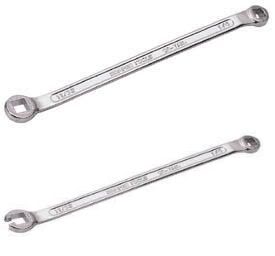|
| |
Rebuilding a Wire Wheel
A wheel builder would
have a hub with a gauge to show concentricity and run-out but you can
achieve a wheel good enough to run smoothly at more than the legal
limit with just a steel rule, a spirit level and a good spoke key.
Available spoke keys can be a little lacking in torque but a brake
adjuster can be easily modified for the purpose. You can buy a brake
adjuster for just a couple of pounds on eBay. You need a ¼" square
adjuster but you will need to make a slight modification to it. You
need to cut a slot in one side wide enough to permit it to pass over
the spokes.

Starting with an unassembled hub and rim mount four spokes at 12
o'clock, 6 o'clock 3 and 9 and try to achieve the closest
approximation to equal distances between hub and rim at the four
points. This is not too difficult but you will also need to ensure
good run-out as you add more spokes. This is where the spirit level
comes into play.
Position the wheel horizontally with the rim on a level surface. You
may need to pack selectively to achieve dead level. You can now place
the spirit level on the outer face of the hub and adjust the spokes to
achieve the combination of concentric position along with level hub.
You will need to check both 12 o'clock 6 and 3 o'clock 9 directions.
The following drawing shows how the spokes connect between hub and rim
and by inspection you can see which spokes tip the hub in the desired
direction. Adjustments should be a combination of increasing tension
on one side whilst reducing it on the other.
.JPG)
It takes a bit of trial and error to achieve concentricity combined
with a level wheel hub but it's not as difficult as you'd imagine. The
final adjustment is spoke tension. Try tapping the spokes on an
already built wheel. They should all ring with the same note. Now give
a final tweak to your re-built wheel to achieve the same pitch to all
the spokes and re-check the distance between hub and rim at all angles
and the levelness of the rim and you are almost there. The only job
remaining is to grind off the protuding ends of the spokes so that the
adjusters rather than the spoke ends are higher. See also:
Eliminating
Vibration.
| |
|
